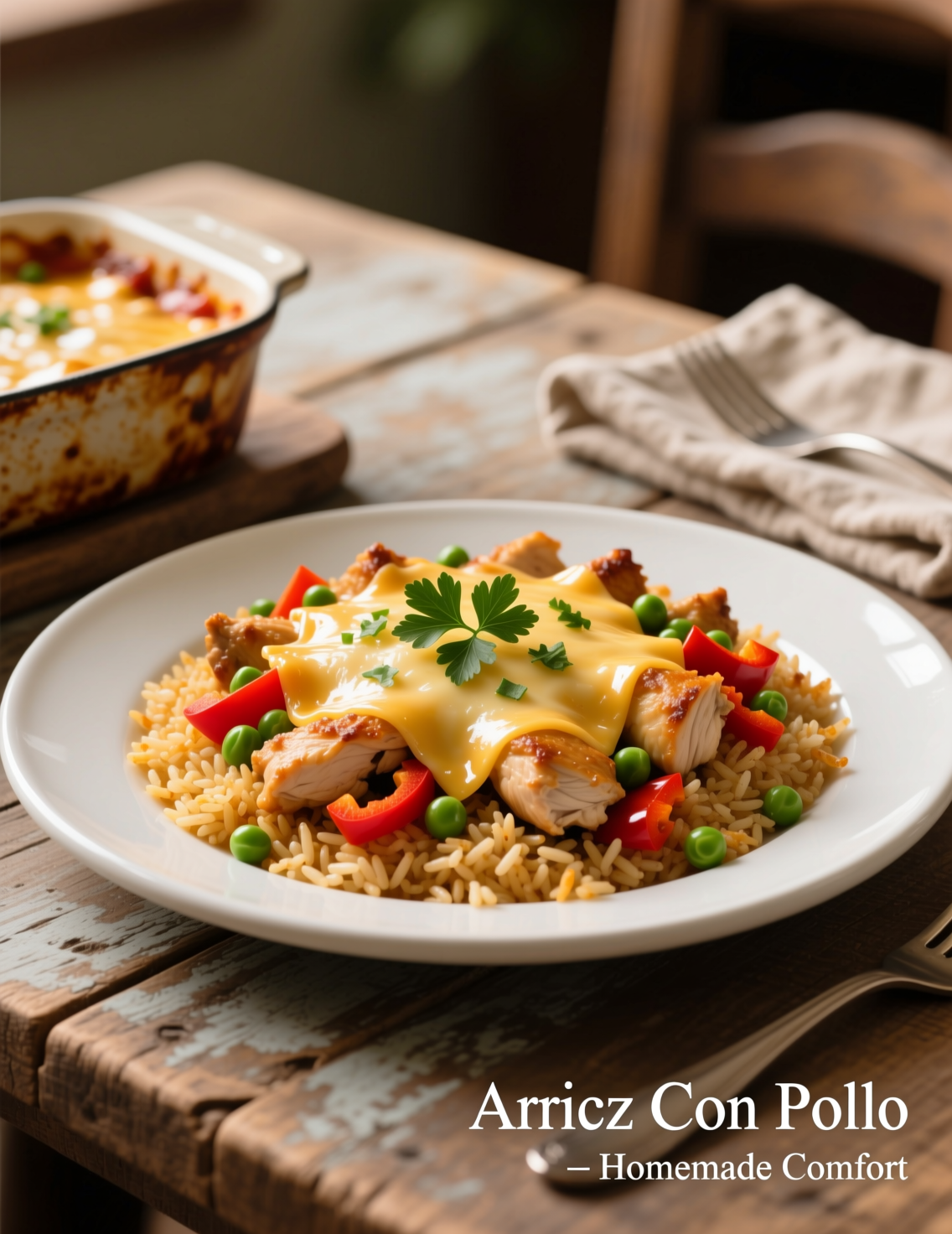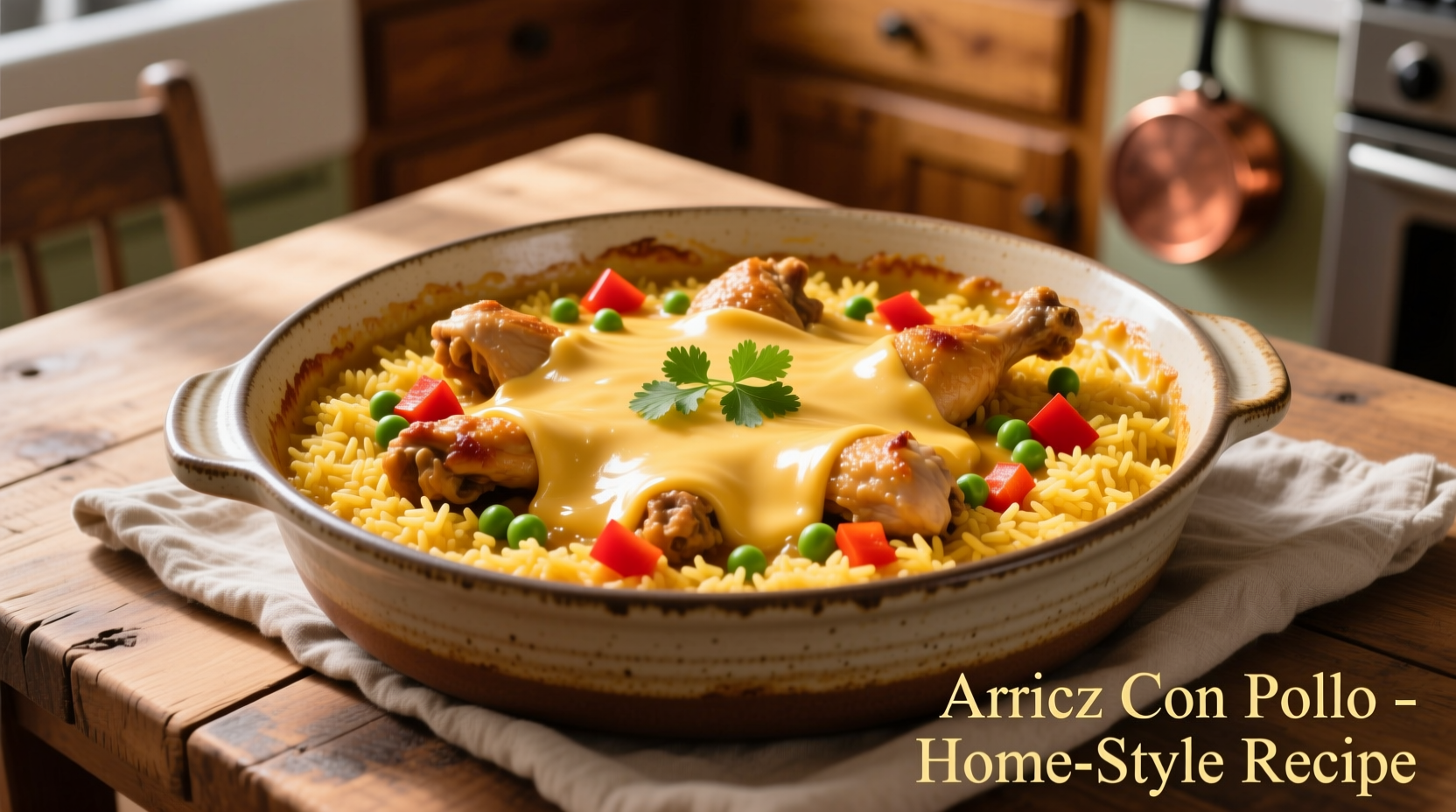Few dishes carry the weight of comfort quite like Arroz Con Pollo. The name translates to “rice with chicken,” yet that feels too simple for what this plate actually delivers. When layered with cheese, slow-cooked spices, and tender chicken, it becomes a meal that’s hearty enough for family gatherings and refined enough for restaurant menus. The purpose of this article is not just to give you a recipe, but to explore the technique, the cultural weight, and the culinary science that makes this dish a timeless favorite.
Why Arroz Con Pollo Still Matters
Arroz Con Pollo is centuries old, tracing back to Spain before spreading to Latin America and the Caribbean. Each region adapted it with what was local—sofrito in Puerto Rico, annatto in Cuba, saffron in Spain. Today, chefs experiment with cheese, cream, and even roasted peppers to create variations that are rooted in tradition but not chained to it.
For a professional cook, the dish embodies balance. You have the starch of rice, the fat of cheese, the protein of chicken, and the aromatics of onion and garlic all dancing together. Nutritionists often point out that the macros in this dish line up with a “complete meal” model. That’s rare in comfort food.
Ingredients That Define Success
For 6 servings, the baseline ingredients go like this:
- 2 pounds bone-in chicken thighs, skin removed
- 2 cups long-grain rice, rinsed until water runs clear
- 4 cups chicken stock (low sodium, homemade if possible)
- 1 medium onion, finely chopped
- 1 green bell pepper, diced
- 3 cloves garlic, minced
- 1 cup canned diced tomatoes
- 1 cup shredded cheddar or Monterey Jack cheese
- 2 teaspoons smoked paprika
- 1 teaspoon ground cumin
- ½ teaspoon turmeric or saffron (if budget allows)
- ½ teaspoon chili flakes (optional)
- 1 cup frozen peas
- 2 tablespoons olive oil
- Salt and black pepper to taste
- Fresh cilantro or parsley for garnish
It’s worth noting that not all cheese behaves the same. Aged cheddar brings sharpness but may oil out under heat. Monterey Jack melts creamier, making it a safer option if consistency matters more than punch. Professionals in test kitchens often blend cheeses to get the best of both worlds.

Prepping Chicken the Right Way
One common mistake? Browning the chicken too fast. The sear isn’t just about looks—it builds fond at the bottom of the pot, which later dissolves into the rice stock, deepening flavor. Chicken thighs are preferred because they stay juicy under long cooking times. Some chefs argue drumsticks give more collagen, but thighs offer a better meat-to-bone ratio for family service.
Brining is optional but recommended. A quick 30-minute brine in salted water ensures the chicken seasons from the inside out. If skipped, the surface seasoning must be aggressive enough to carry through the rice.
Rice Is Not Just Rice
Long-grain rice is the classic pick for Arroz Con Pollo. It stays fluffy instead of clumping. Basmati is acceptable but leans perfumed, which can overpower the dish. Short-grain varieties, like arborio, cling too much and create a risotto-like texture—not wrong, but not traditional.
The rinsing step matters more than most cooks think. Starch left on grains leads to gummier textures. Food scientists have measured up to a 15% difference in final fluffiness between rinsed and unrinsed batches. Professionals can’t ignore those numbers.
The Sofrito Foundation
Every solid Arroz Con Pollo begins with a sofrito—or its cousin. That means sweating onions, peppers, and garlic until their sugars release. The process is slow, sometimes 10 minutes on low heat, but it builds a sweet-savory bed. Tomatoes then add acidity and body. Skipping sofrito is like trying to make bread without letting dough rise. You might end up with food, but not the real dish.
Cooking Method: Layering Flavor
- Heat olive oil in a Dutch oven.
- Sear chicken thighs until golden, remove and set aside.
- In the same pot, build sofrito with onion, pepper, and garlic.
- Stir in rice, letting grains toast lightly in oil. This adds a nutty depth.
- Add spices—paprika, cumin, turmeric—blooming them in heat for 30 seconds.
- Pour in stock and tomatoes, stir well.
- Return chicken to pot, nestling into rice. Cover and cook on low for 25–30 minutes.
- Add peas in the last 5 minutes.
- Off the heat, fold in shredded cheese. Cover and let rest 10 minutes before serving.
The resting step is not negotiable. Rest allows starches in the rice to reabsorb moisture, and the cheese to fully meld into the dish. Cut corners here and the plate feels sloppy.
Cheese: Tradition Meets Modern
Purists might raise eyebrows at cheese in Arroz Con Pollo. Historically, it wasn’t there. Yet cuisine evolves. Chefs like José Andrés have introduced creamy elements in variations to appeal to broader audiences. Data from restaurant menu trends shows “cheesy rice bowls” grew 28% in popularity across U.S. menus in the last decade. So cheese is not only acceptable—it’s commercially viable.
Adding cheese also makes the dish more appealing to younger eaters. A case study from the National Chicken Council noted that cheese-based chicken dishes rank among the top three sellers in family restaurants. For professionals designing menus, that’s a signal worth listening to.
Common Pitfalls
Overcooking rice is the number one sin. This usually happens when stock-to-rice ratios are off. Stick to about 2 cups liquid per cup of rice, adjusting slightly for humidity and grain type.
Another mistake is dumping cheese in too early. If cheese melts into the stock instead of folding in at the end, you risk greasy separation. Professionals call this “breaking the emulsion,” and once it’s broken, no technique fixes it.
Finally, don’t go heavy on turmeric. It stains the rice brilliantly yellow, but too much tastes metallic. A pinch is plenty.
Variations Across Borders
In Cuba, the dish often leans on annatto for color. Puerto Rican versions may use beer instead of stock. Colombian cooks sometimes fold in plantains, adding sweetness. The cheesy version is more of a U.S. fusion, but it stands firmly in the family of comfort-driven adaptations.
Chefs experimenting in fine dining settings often present it deconstructed: a crisp chicken thigh perched atop a bed of saffron rice, with cheese espuma piped delicately on top. It looks elegant, though one could argue it loses the “one-pot soul” of the original.

Nutritional Breakdown
One serving of this 6-portion recipe, averaged out, comes close to:
- 520 calories
- 28g protein
- 18g fat
- 54g carbohydrates
For professional dietitians, this aligns with a balanced lunch plate. The fiber from vegetables and peas adds digestive benefits, while the cheese contributes calcium. Some chefs lower fat by removing skin and using reduced-fat cheese, but flavor tends to suffer.
Why It Works in Kitchens
Arroz Con Pollo with cheese holds strong practical value in professional kitchens. It scales easily. It keeps well under warming lamps for service. And leftovers reheat without collapsing in texture. That trifecta—scalable, holdable, reheatable—makes it an operational win.
In catering studies, rice-based one-pot meals cut prep time by nearly 20% compared to plated multi-component meals. That’s not small when feeding 200 guests.
Pairings and Serving Notes
This dish thrives with a simple green salad, something acidic like lime-dressed arugula. Fried plantains also make a natural pairing. For beverages, a crisp lager or a citrus-forward white wine cuts through richness.
In home kitchens, it’s often served family-style in the same pot it was cooked in. That’s more than convenience—it’s theater. When the lid lifts and steam escapes, it sets the tone of abundance at the table.
Final Thoughts
Arroz Con Pollo is not just a recipe; it’s a masterclass in layering flavor, balancing nutrition, and understanding cultural evolution in food. The cheesy twist may not be old-world authentic, but it reflects the way cuisine adapts to taste and demand.
For professionals, this dish teaches discipline. From rice ratios to cheese timing, each detail matters. For home cooks, it’s comfort in a pot. For diners, it’s a plate that satisfies without pretense.
Make it with respect, and it rewards you with flavor that feels both familiar and new. That’s the true magic of Arroz Con Pollo—timeless yet always ready for the next chapter.
FAQs
What is Arroz Con Pollo?
A traditional Latin American dish of chicken and rice, here made cheesy for extra flavor.
How many servings does this recipe make?
This recipe serves 6 people.
Can I use chicken breasts instead of thighs?
Yes, but thighs stay juicier and more flavorful during cooking.
Do I need to rinse the rice?
Yes, rinsing removes excess starch for fluffier rice.
What type of cheese works best?
Monterey Jack melts creamier, cheddar adds sharper flavor.
Can I make this dish ahead of time?
Yes, it reheats well and flavors deepen after resting.
Is it okay to add vegetables?
Absolutely, peas are included, but bell peppers or plantains work too.
Can I skip the saffron or turmeric?
Yes, they add color and subtle flavor but are optional.
How long should I cook the rice with chicken?
About 25–30 minutes on low heat until rice absorbs liquid.
Can I make this gluten-free?
Yes, all ingredients are naturally gluten-free.
Should I add cheese while cooking or after?
Add cheese at the end off-heat to prevent separation.
What can I serve with Arroz Con Pollo?
Green salad, fried plantains, or a citrus-forward white wine pair well.
Is this recipe suitable for meal prep?
Yes, it stores and reheats well for several days.
Can I use instant rice for this recipe?
Not recommended; it may overcook and become mushy.
Does this dish work in restaurants?
Yes, it scales easily and holds well under warming lamps.

Mariana is a passionate home cook who creates delicious, easy-to-follow recipes for busy people. From energizing breakfasts to satisfying dinners and indulgent desserts, her dishes are designed to fuel both your body and hustle.
When she’s not in the kitchen, she’s exploring new flavors and dreaming up her next recipe to share with the Foodie Hustle community.

